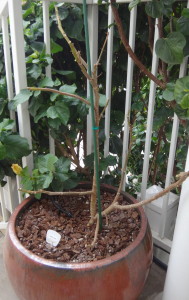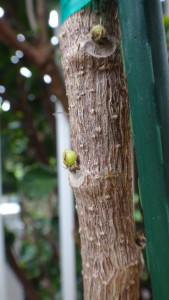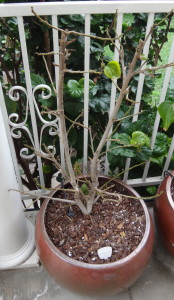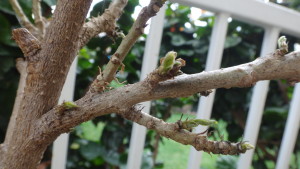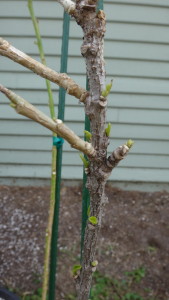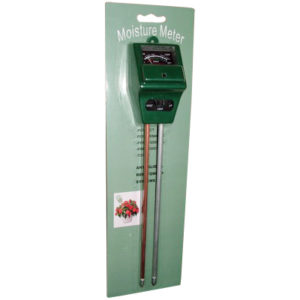End of January and 1st Spring Growth Spurts are Starting!
It is rather amazing to see that in the 2nd half of January we are already starting to see the first new growth spurts for our hibiscus plants here in Southern California. Even though some of the plants look like they are dead they are in hibernation waiting for the right conditions to trigger the production of new growth. A combination of longer days, warmer nights and a plant’s uncanny ability to know what time of the year it is all come together to start growing again.
Mango Tango w/ 1st new growth
Tahitian Sunset Splendor w/ new growth
David Orr w/ new growth
It is amazing how a plant can look like it is dead but is just in hibernation. A good way to know is to do a scratch test. Take your fingernail or the side of your pruning shears and gently scratch the surface of a branch or trunk. Make just a tiny small scratch until you get past the outer layer of bark. Underneath you should see a bright green layer which indicates a healthy plant that is just waiting for the right conditions to start growing again.
If you can place a plant that has gone dormant inside with a grow light and good heating you will be amazed how quickly it will wake up and start leafing away again. For those of us who don’t have the space or resources it is a challenge to watch your plants slow down, lose their leaves and eventually shut down until the seasons start to change again. Nature knows how to survive, we just need to know how to understand that and work with it.
One of the most common mistakes made during the colder months is to continue watering and feeding plants that are or in the process of shutting down. My two plants above (Tahitian Sunset Splendor & Mango Tango) have not been watered or fed since late October. I use a moisture meter all year round to check the soil in all my potted plants before watering or feeding.
I have found the most dangerous time to get root rot started is during heat waves in summer. This is surprising considering that root rot is always associated with cold weather and wet soil. But my experience is that it is those heat waves where we think our plants are in need of extra water that we start that process going. When you see the top of the soil in your pots looking bone dry it is an instinctful reaction that they must need water. But if you take a moisture meter and slowly insert it into the soil you will see how many times the top layer of soil is dry and towards the bottom of your pot it is very wet still. The last thing your plant needs at that point is to saturate that bottom layer of soil even more. Unless your pots have exceptional drainage you will eliminate any existing air pockets in the soil down low and that is the perfect environment for root rot to start. Once the weather cools off then the pathogens will multiply like crazy and you will have a disaster on your hands.
It goes against our nature to not water for weeks and months at a time but once your plant shuts down don’t give it anything. The roots are not taking up any water so you are just making the soil a breeding ground for root rot pathogens. The only water my potted plants got was from any rain events we had and that had me nervous as that could push the soil environment over the edge into root rot heaven. If your pots are small enough and you have protected areas from rain I highly recommend moving them during any rain events if your plants are not growing any more or have shut down.
If you can plant your hibiscus in the ground then you are very fortunate and don’t have to worry much about this whole problem. One word of advise for in ground exotic hibiscus is make sure when you plant them you make huge holes and fill them with soil that has excellent drainage. Also do not put a layer of rocks or pumice on the bottom of your holes as that can actually create a seal that does not allow your hole to drain. Then you can get root rot for in ground exotic hibiscus. But if you do it right your plants can withstand an amazing amount of negative impacts from the environment.
Happy Hibiscusing!
